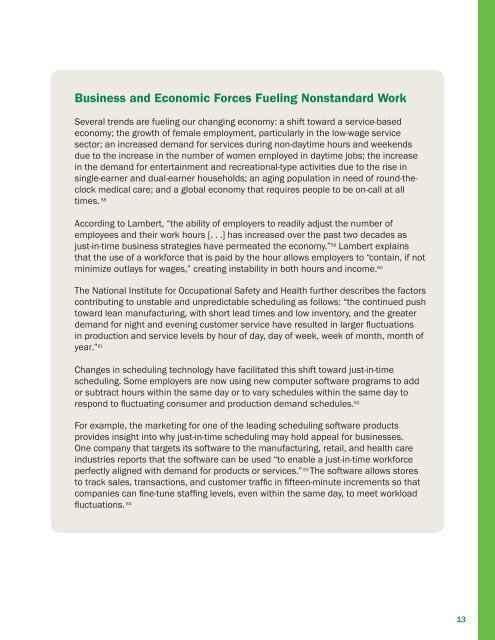Flexible Workplace Solutions for Low-Wage Hourly Workers
Flexible Workplace Solutions for Low-Wage Hourly Workers
Flexible Workplace Solutions for Low-Wage Hourly Workers
You also want an ePaper? Increase the reach of your titles
YUMPU automatically turns print PDFs into web optimized ePapers that Google loves.
Business and Economic Forces Fueling Nonstandard Work<br />
Several trends are fueling our changing economy: a shift toward a service-based<br />
economy; the growth of female employment, particularly in the low-wage service<br />
sector; an increased demand <strong>for</strong> services during non-daytime hours and weekends<br />
due to the increase in the number of women employed in daytime jobs; the increase<br />
in the demand <strong>for</strong> entertainment and recreational-type activities due to the rise in<br />
single-earner and dual-earner households; an aging population in need of round-theclock<br />
medical care; and a global economy that requires people to be on-call at all<br />
times. 58<br />
According to Lambert, “the ability of employers to readily adjust the number of<br />
employees and their work hours [. . .] has increased over the past two decades as<br />
just-in-time business strategies have permeated the economy.” 59 Lambert explains<br />
that the use of a work<strong>for</strong>ce that is paid by the hour allows employers to “contain, if not<br />
minimize outlays <strong>for</strong> wages,” creating instability in both hours and income. 60<br />
The National Institute <strong>for</strong> Occupational Safety and Health further describes the factors<br />
contributing to unstable and unpredictable scheduling as follows: “the continued push<br />
toward lean manufacturing, with short lead times and low inventory, and the greater<br />
demand <strong>for</strong> night and evening customer service have resulted in larger fl uctuations<br />
in production and service levels by hour of day, day of week, week of month, month of<br />
year.” 61<br />
Changes in scheduling technology have facilitated this shift toward just-in-time<br />
scheduling. Some employers are now using new computer software programs to add<br />
or subtract hours within the same day or to vary schedules within the same day to<br />
respond to fl uctuating consumer and production demand schedules. 62<br />
For example, the marketing <strong>for</strong> one of the leading scheduling software products<br />
provides insight into why just-in-time scheduling may hold appeal <strong>for</strong> businesses.<br />
One company that targets its software to the manufacturing, retail, and health care<br />
industries reports that the software can be used “to enable a just-in-time work<strong>for</strong>ce<br />
perfectly aligned with demand <strong>for</strong> products or services.” 63 The software allows stores<br />
to track sales, transactions, and customer traffi c in fi fteen-minute increments so that<br />
companies can fi ne-tune staffi ng levels, even within the same day, to meet workload<br />
fl uctuations. 64<br />
13

















